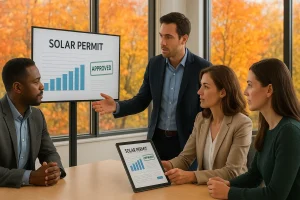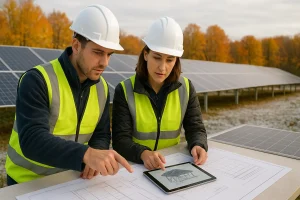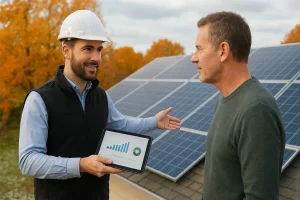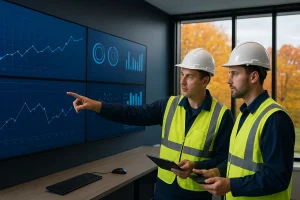Leaves Fall, Permits Fly: How Autumn Accelerates Solar Installations

Why Fall Is the Perfect Season to Accelerate Solar Projects
It’s late September, and while your competitors are wrapping up their summer installs and preparing for the slow season, you’re closing more solar deals than ever. Sound impossible? Think again. Autumn solar installations present a massive untapped opportunity that smart solar installers and EPCs are leveraging to dominate their markets. The problem isn’t that fall and winter lack potential – it’s that most installers haven’t cracked the code on seasonal advantages. The solution lies in understanding how fall solar permits process faster, customer psychology shifts favorably, and installation conditions actually improve during cooler months.
Why Autumn Solar Installation Outperforms Summer Rush
Faster Permit Processing During Fall Season
Here’s the game-changer most installers miss: autumn solar permits fly through approval processes at lightning speed compared to summer bottlenecks. Recent NREL data shows that automated permitting platforms like SolarAPP+ can reduce full permitting timelines by 31%, cutting typical approval times from 47.5 days to just 33 days. During autumn’s reduced demand, these improvements become even more pronounced.

The mathematics are compelling. Soft costs still account for roughly two-thirds of total residential system costs, with permitting delays being a major contributor. When fall solar installation schedules align with faster processing times, your profit margins expand significantly.
Competitive Advantages of Off-Season Solar Projects
Smart installers understand that winter solar installation benefits extend far beyond simple scheduling convenience. During fall and winter months, solar contractors experience lighter workloads, allowing greater flexibility for prompt project accommodation and efficient issue resolution. This translates to several competitive advantages:
Pricing Power: Fall installation timing often results in better pricing negotiations, as installers prefer accepting projects at reduced rates rather than having no work during slower seasons.
Quality Focus: Reduced schedule pressure means installation crews can dedicate more attention to each project, improving overall quality and customer satisfaction.
Customer Priority: Your clients receive personalized attention that’s impossible during summer’s hectic pace.
The Science Behind Cold Weather Solar Efficiency
Temperature Performance Optimization
Here’s what separates experienced professionals from newcomers: understanding that cold weather solar performance actually exceeds summer efficiency. Solar panels operate more efficiently in colder weather, as temperatures above 77°F cause decreases in voltage and overall system performance.
This technical advantage means autumn solar systems installed properly will outperform summer installations once operational. Research demonstrates that solar panels begin losing efficiency around 77°F, making cooler fall conditions optimal for maximum energy conversion.
Seasonal Solar Production Benefits
The seasonal solar installation strategy pays dividends throughout the year. Properly designed systems can overproduce during spring, summer, and early fall to build utility credit banks that carry homeowners through winter months. Installing during autumn ensures systems are fully operational when spring production peaks begin.
Engineering Excellence for Fall Solar Projects
Weather-Resistant Design Considerations
Professional fall solar engineering requires understanding winter weather challenges. Snow loads, ice formation, and thermal cycling demand specific design considerations including proper elevation above snow depths and strategic module orientation.

Key Engineering Factors:
- Snow load calculations for local climate conditions
- Proper drainage and module positioning for ice prevention
- Strategic racking design for winter maintenance access
- Temperature coefficient optimization for cold weather performance
Installation Safety and Efficiency
Autumn installation conditions actually favor safer, more efficient work environments. Installation workers prefer cooler temperatures over summer’s dangerous rooftop heat, which can reach 160°F on asphalt surfaces. This preference translates into:
- Reduced heat-related safety incidents
- Improved worker productivity and focus
- Lower risk of weather-related installation delays
- Enhanced equipment handling and precision
Market Psychology and Customer Acquisition
Year-End Tax Incentive Urgency
Q4 solar sales benefit from powerful psychological motivators. Customers face genuine year-end deadlines for federal tax credit qualification, creating natural urgency that doesn’t require artificial pressure tactics. Missing year-end deadlines could mean waiting another year for tax advantage programs, potentially costing customers thousands in savings.
Autumn Customer Decision-Making Patterns
Fall solar marketing succeeds because customer mindsets align with harvest season mentality – making important investments before winter arrives. Energy bills typically spike during colder months, making solar’s value proposition more tangible and immediate.
Effective Messaging Strategies:
- Emphasize winter energy cost protection
- Highlight system readiness for peak spring production
- Leverage tax deadline urgency authentically
- Focus on proactive winter energy security
Overcoming Common Autumn Solar Installations Objections
Weather and Performance Concerns
Many customers worry about winter solar efficiency, but educated installers turn this into competitive advantage. Solar panels produce substantial electricity during fall and winter, and systems work efficiently even during cloudy conditions, generating 10-25% of standard output on overcast days.

Professional responses include:
- Explaining optimal temperature performance ranges
- Demonstrating annual production modeling
- Sharing local cold-climate success stories
- Providing winter maintenance guidance
Installation Timeline Misconceptions
Address seasonal installation timelines proactively. The solar installation process typically involves 90 days of paperwork, permits, and utility coordination, making fall agreements perfect for spring completion timing.
Maximizing Fall Installation Opportunities
Streamlined Project Management
Autumn solar projects succeed through systematic approach optimization. Reduced competition means:
- Faster permit approvals and utility interconnections
- Improved vendor relationships and material availability
- Enhanced customer communication and project attention
- Reduced subcontractor scheduling conflicts
Strategic Business Planning
Forward-thinking installers use fall installation seasons for strategic positioning:
Operational Benefits:
- Cash flow stabilization during traditionally slow periods
- Crew retention through consistent work availability
- Vendor relationship strengthening through off-season partnerships
- Market share expansion while competitors hibernate
Growth Opportunities:
- Customer referral program optimization during extended project timelines
- Technical training and certification advancement for crew members
- New market territory expansion during reduced competition
- Partnership development with complementary service providers
Technology Integration for Autumn Success
Advanced Monitoring and Maintenance
Winter solar monitoring requires sophisticated approaches. Modern systems integrate weather compensation algorithms and predictive maintenance scheduling that account for seasonal variations.

Smart Grid Integration
Cold climate solar systems benefit from advanced inverter technology and grid-tie optimization. Proper system design includes load balancing for winter energy consumption patterns and battery integration for grid resilience during winter storms.
Conclusion: Partner with EnergyScape for Autumn Excellence
Smart solar installers recognize that autumn solar installation opportunities dwarf summer’s crowded marketplace. The combination of faster permitting, improved installation conditions, enhanced customer psychology, and superior system performance creates unbeatable competitive advantages.
At EnergyScape Renewables, we’ve perfected the art and science of fall solar engineering. Our nationwide licensing and comprehensive design expertise ensure your autumn projects exceed expectations from initial consultation through final interconnection. We understand that successful seasonal solar installations require technical precision, regulatory expertise, and project management excellence.
Whether you’re planning utility-scale developments or residential installations, our engineering solutions optimize every aspect of autumn solar projects. From cold-weather performance optimization to accelerated permitting strategies, we’re your partner for profitable fall installations.
Ready to discover how winter solar installation can transform your business? Visit Sunscape Solar to explore innovative solutions that maximize autumn opportunities while building lasting customer relationships.
Don’t let another autumn pass while competitors struggle with summer bottlenecks. Contact EnergyScape Renewables today and watch your fall solar permits fly through approvals while your profits soar.

sjayakanth@energyscaperenewables.com